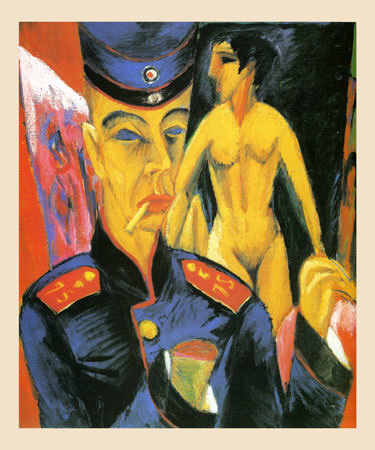Next Saturday a new exhibition of the work of the German Expressionist painter, Ernst Ludwig Kirchner, opens at the Royal Academy of Arts in London. This week’s picture is one of his most striking inventions: Self-Portrait as a Soldier, which is sometimes also known by the title Self-Portrait with a Severed Hand. It was during the First World War, when the artist was convalescing after having been discharged from the German army.
Kirchner was an unwilling soldier. In the spring of 1915, to avoid being conscripted into the regular infantry, he signed on as an artillery driver. Not long afterwards, reportedly suffering the effects of a nervous breakdown, he was temporarily exempted from army service. He subsequently developed a drink problem and became addicted both to the morphine and the sleeping pills which had been prescribed for him. By November his condition had worsened to the point where he was declared unfit for military service. At some point during this annus horribilis he painted the picture reproduced on this page.
The setting is the artist’s studio. An unfinished painting, raw as a wound, is leaned up against one of the walls, while at the room’s centre a model poses against a black screen. Kirchner believed that study of the nude figure “in a free, natural state” was “the foundation of all visual art”. But the painter’s green-tinged, neurasthenic face is averted both from his work and its sources of inspiration. He turns instead to confront the spectator. He wears the uniform of Field Artillery Regiment No. 75, depicted with historical accuracy: dark blue uniform, trimmed with red, with red epaulets; matching cap embossed with two cockades representing Prussia and the German Reich. A cigarette dangles from the corner of his mouth and he has black unseeing eyes....


